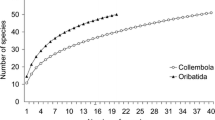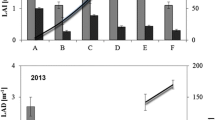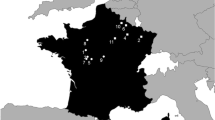Abstract
With the aim of increasing knowledge of community structure, dynamics and production of ectomycorrhizal fungi, edible sporocarp yields were monitored between 1995 and 2004 in a Pinus sylvestris stand in the northeast zone of the Iberian Peninsula. A random sampling design was performed by stand age class according to the forest management plan: 0–15, 16–30, 31–50, 51–70 and over 71-years-old. Eighteen 150 m plots were established and sampled weekly every year from September to December. One hundred and nineteen taxa belonging to 51 genera were collected, 40 of which were edible and represented 74% of the total biomass. Boletus edulis, Lactarius deliciosus, Cantharellus cibarius and Tricholoma portentosum sporocarps, which are considered to be of high commercial value, represented 34% of the total production. B. edulis and L. deliciosus were the most remarkable and abundant species, and both were collected in more than 60% of the samplings. B. edulis fructified every year of the experiment; its mean production was 40 kg/ha and year and its maximum productivity was more than 94 kg/ha in 1998. The age class with the largest production of this taxa was the fourth (51–70 years), with 70 kg/ha. L. deliciosus only failed to fructify one autumn (2000); its mean production was almost 10 kg/ha and its maximum productivity close to 30 kg/ha in 1997. The maximum productivity of this species was found in the second (16–30 years) and fifth (71–90 years) stand age classes, with 18 and 16 kg/ha, respectively. Advances in this field can certainly offer new insights into factors affecting sporocarp production.
Similar content being viewed by others
References
Alexander SJ, Pilz D, Weber NS, Brown E, Rockwell VA (2002) Value estimates of commercial mushrooms and timber in the Pacific Northwest. Environ Manage 30:129–141
Arnolds E (1995) Conservation and management of natural populations of edible fungi. Can J Bot 73:987–998
Baptista P, Martins A, Tavares RM, Lino-Neto T (2010) Diversity and fruiting pattern of macrofungi associated with chestnut (Castanea sativa) in the Trás-os-Montes region (Northeast Portugal). Fungal Ecol 3:9–19
Barroetaveña C, La Manna L, Alonso MV (2008) Variables affecting Suillus luteus fructification in ponderosa pine plantations of Patagonia (Argentina). For Ecol Manag 256:1868–1874
Boa E (2004) Wild edible fungi: a global overview of their use and importance to people. FAO, Rome
Bonet JA, Fischer CR, Colinas C (2004) The relationship between forest age and aspect on the production of sporocarps of ectomycorrhizal fungi in Pinus sylvestris forests of the central Pyrenees. For Ecol Manag 203:157–175
Breitenbach J, Kränzlin F (1981–2000) Champignons de Suisse. Fungi of Switzerland. Edition Mykologia, Lucerne
Brummit RK, Powell CE (eds) (1992) Authors of plant names. Royal Botanic Gardens, Kew
Buée M, Maurice JP, Zeller B, Andrianarisoa S, Ranger J, Courtecuisse R, Marçais B, Le Tacon F (2011) Influence of tree species on richness and diversity of epigeous fungal communities in a French temperate forest stand. Fungal Ecol 4:22–31
Cannon PF, Kirk PM (2007) Fungal families of the world. CABI UK Centre, Egham
Dahlberg A, Jonsson L, Nylund JE (1997) Species diversity and distribution of biomass above and below ground among ectomycorrhizal fungi in an old-growth Norway spruce forest in south Sweden. Can J Bot 75:1323–1335
De Román M, Boa E (2004) Collection, marketing and cultivation of edible fungi in Spain. Micol Apl Int 16:25–33
De Román M, Boa E (2006) The marketing of Lactarius deliciosus in northern Spain. Econ Bot 60:284–290
Dennis RWG (1968) British ascomycetes. Cramer, Lehre
Díaz-Balteiro L, Álvarez-Nieto A, Oria-de-Rueda JA (2003) Integración de la producción fúngica en la gestión forestal. Aplicación al monte "Urcido" (Zamora). Inv Agr Sist Rec For 121:15–19
Dighton J, Mason PA (1985) Mycorrhizal dynamics during forest tree development. In: Moore D, Casselton LA, Wood DA, Franklan JC (eds) Developmental biology of higher fungi. Cambridge University Press, Cambridge, pp 117–139
Dighton J, Poskitt JM, Howard DM (1986) Changes in occurrence of basidiomycete fruit bodies during forest stand development: with specific reference to mycorrhizal species. Trans Br Mycol Soc 87:163–171
Dreisbach TA, Smiths JE, Molina R (2002) Challenges of modelling fungal habitat: when and where do you find chanterelles. In: Scoot JM, Heglund PJ, Morrison M, Raphael M, Haufler J, Wall B (eds) Predicting species occurrences: issues of scale and accuracy. Island Press, Covello
Egli S, Peter M, Buser C, Stahel W, Ayer F (2006) Mushroom picking does not impair future harvests—results of a long-term study in Switzerland. Biol Conserv 129:271–276
Egli S, Ayer F, Peter M, Eilmann B, Rigling A (2010) Is forest mushroom productivity driven by tree growth? Results from a thinning experiment. Ann For Sci 67:509
Einot I, Gabriel KR (1975) A study of the power of several methods of multiple comparisons. J Am Stat Assoc 70:351–361
Fernández-Toirán LM (1994) Estudio de la producción micológica actual en la comarca de Pinares de Soria y ensayo de técnicas de mejora de la misma. Universidad de Santiago de Compostela
Fernández-Toirán LM, Ágreda T, Olano JM (2006) Stand age and samplig year effect on the fungal fruit body community in Pinus pinaster forests in central Spain. Can J Bot 84:1249–1258
Ferris R, Peace AJ, Newton AC (2000) Macrofungal communities of lowland Scots pine (Pinus sylvestris L.) and Norway spruce (Picea abies (L.) Karsten) plantations in England: relationships with factors and factors and stand structure. For Ecol Manag 131:255–267
Hintikka V (1988) On the macromycete flora in oligotrophic pine forests of different ages in South Finland. Acta Bot Fenn 136:89–94
Jülich W (1989) Guida alla determinazione dei funghi. Vol. 2. Aphyllophorales, Heterobasidiomycetes, Gastromycetes, Saturnia, Trento
Kalamees K, Silver S (1988) Fungal productivity of pine heaths in north-west Estonia. Acta Bot Fenn 136:95–98
Kardell L, Eriksson L (1987) Kremlor, riskor, soppar. Skogsbruksmetodernas inverkan pa produktionen av matsvampar. Sverisges Skogsvardsförbunds Tidskr 2:3–23
Keizer PJ, Arnolds E (1994) Succession of ectomycorrhizal fungi in roadside verges planted with common oak (Quercus robur L.) in Drenthe, the Netherlands. Mycorrhiza 4:147–159
Kranabetter JM, Friesen J, Gamlet S, Kroeger P (2005) Ectomycorrhizal mushroom distribution by stand age in western hemlock—lodgepole pine forests of northwestern British Columbia. Can J For Res 35:1527–1539
Last FT, Mason PA, Pelham J, Ingleby K (1984) Fruitbody production by sheating mycorrhizal fungi—effects of host genotypes and propagating soils. For Ecol Manag 9:221–227
Martínez de Aragón J, Bonet JA, Fischer CR, Colinas C (2007) Productivity of ectomycorrhizal and selected edible saprotrophic fungi in pine forests of the pre-Pyrenees mountains, Spain: predictive equations for forest management of mycological resources. For Ecol Manag 252:239–256
Martínez-Peña F, García-Cid R (2003) Ordenación del recurso micológico en la comarca de Pinares Soria-Burgos. Actas XII Congreso Forestal Mundial, Québec, Canada. ISBN: 2-923174-02-X
Martínez-Peña F, Gómez Conejo R, Ortega-Martínez P (2006–2010) MICODATA—Sistema de información geográfica sobre la producción, aprovechamiento y ordenación del recurso micológico en Castilla y León. http://www.micodata.es. Accessed 30 December 2010
Martín-Pinto P, Vaquerizo H, Peñalver F, Olaizola J, Oria-de-Rueda JA (2006) Early effects of a wildfire on the diversity and production of fungal communities in Mediterranean vegetation types dominated by Cistus ladanifer and Pinus pinaster in Spain. For Ecol Manag 225:296–305
Mason PA, Last FT, Pelham J, Ingleby K (1982) Ecology of some fungi associated with an ageing stand of birches (Betula pendula and B. pubescens). For Ecol Manag 4:19–39
Matsuda Y, Hijii N (1998) Spatiotemporal distribution of fruitbodies of ectomycorrhizal fungi in an Abies firma forest. Mycorrhiza 8:131–138
Moser M (2003) Keys to agarics and boleti, 4th edn. Roger Philips, London
Ohenoja E (1984) Fruit body production of larger fungi in Finland. 1. Introduction to the study in 1976–1978. Acta Bot Fenn 21:349–355
Ohenoja E (1989) Forest fertilization and fruiting body production in fungi. Atti Cent Studi Flora Mediterr 7:233–253
Oria de Rueda JA, Hernández-Rodríguez M, Martín-Pinto P, Pando V, Olaizola J (2010) Could artificial reforestarions provide as much production and diversity of fungal species as natural forest stands in marginal Mediterranean areas? For Ecol Manag 260:171–180
Palahí M, Pukkala T, Bonet JA, Colinas C, Fischer CR, Martínez de Aragón J (2009) Effect of the inclusion of mushroom values on the optimal management of even-aged pine stands of Catalonia. For Sci 55:503–511
Pilz D, Smith J, Amaranthus MP, Alexander S, Molina R, Luoma D (1999) Managing the commercial harvest of the American matsutake and timber in the southern Oregon Cascade Range. J Forest 97:4–11
Salo K (1993) Yields of commercial edible mushroom species in mineral soil forests in Finland, 1985–1986. Aquilo Ser Bot 31:115–121
Senn-Irlet B, Bieri G (1999) Sporocarp succession of soil-inhabiting macrofungi in an autochthonous subalpine Norway spruce forest of Switzerland. For Ecol Manag 124:169–175
Shubin VI (1988) Influence of fertilization on the fruiting of forest mushrooms. Acta Bot Fenn 136:85–87
Smith JE, Molina R, Huso MMP, Luoma DL, McKay D, Castellano MA, Lebel T, Valachovic Y (2002) Species richness, abundance, and composition of hypogeous and epigeous ectomycorrhizal fungal sporocarps in young, rotation-age, and old-growth stands of Douglas-fir (Pseudotsuga menziesii) in the Cascade Range of Oregon, U.S.A. Can J Bot 80:186–204
Straatsma G, Ayer F, Egli S (2001) Species richness, abundance and phenology of fungal fruitbodies over 21 years in a Swiss forest plot. Mycol Res 105:512–523
Väre H, Ohenoja E, Ohtonen R (1996) Macrofungi of oligotrofic Scots pine forests in northern Finland. Karstenia 36:1–18
Vogt KA, Bloomfield J, Ammirati J, Ammirati SR (1992) Sporocarp production by Basidiomycetes, with emphasis on forest ecosystems. In: Carroll GC, Wicklow DT (eds) The fungal community. Its organization and role in the ecosystem. Marcel Dekker, New York, pp 563–581
Wang Y, Hall IR (2004) Edible ectomycorrhizal mushrooms: challenges and achievements. Can J Bot 82:1063–1073
Yagüe L, Ortega-Martínez P, Martín A, Martínez-Peña F (2006) Informe diagnóstico socioeconómico de micodata del aprovechamiento micológico en el ámbito de Asopiva. http://www.micodata.es/beta/docs/informeSocioEconomicoAsopiva01
Zamora-Martínez MC, Nieto Pascual C (1995) Natural production of wild edible mushrooms in the southwestern rural territory of Mexico City, Mexico. For Ecol Manag 72:13–20
Acknowledgements
This work was supported by INIA (Spanish National Institute for Agricultural Research, Spanish Government) project RTA 03-046. We would like to thank the staff at CIF Valonsadero involved in plot network maintenance and mushroom picking in Pinar Grande over the years.
Author information
Authors and Affiliations
Corresponding author
Rights and permissions
About this article
Cite this article
Martínez-Peña, F., Ágreda, T., Águeda, B. et al. Edible sporocarp production by age class in a Scots pine stand in Northern Spain. Mycorrhiza 22, 167–174 (2012). https://doi.org/10.1007/s00572-011-0389-8
Received:
Accepted:
Published:
Issue Date:
DOI: https://doi.org/10.1007/s00572-011-0389-8




